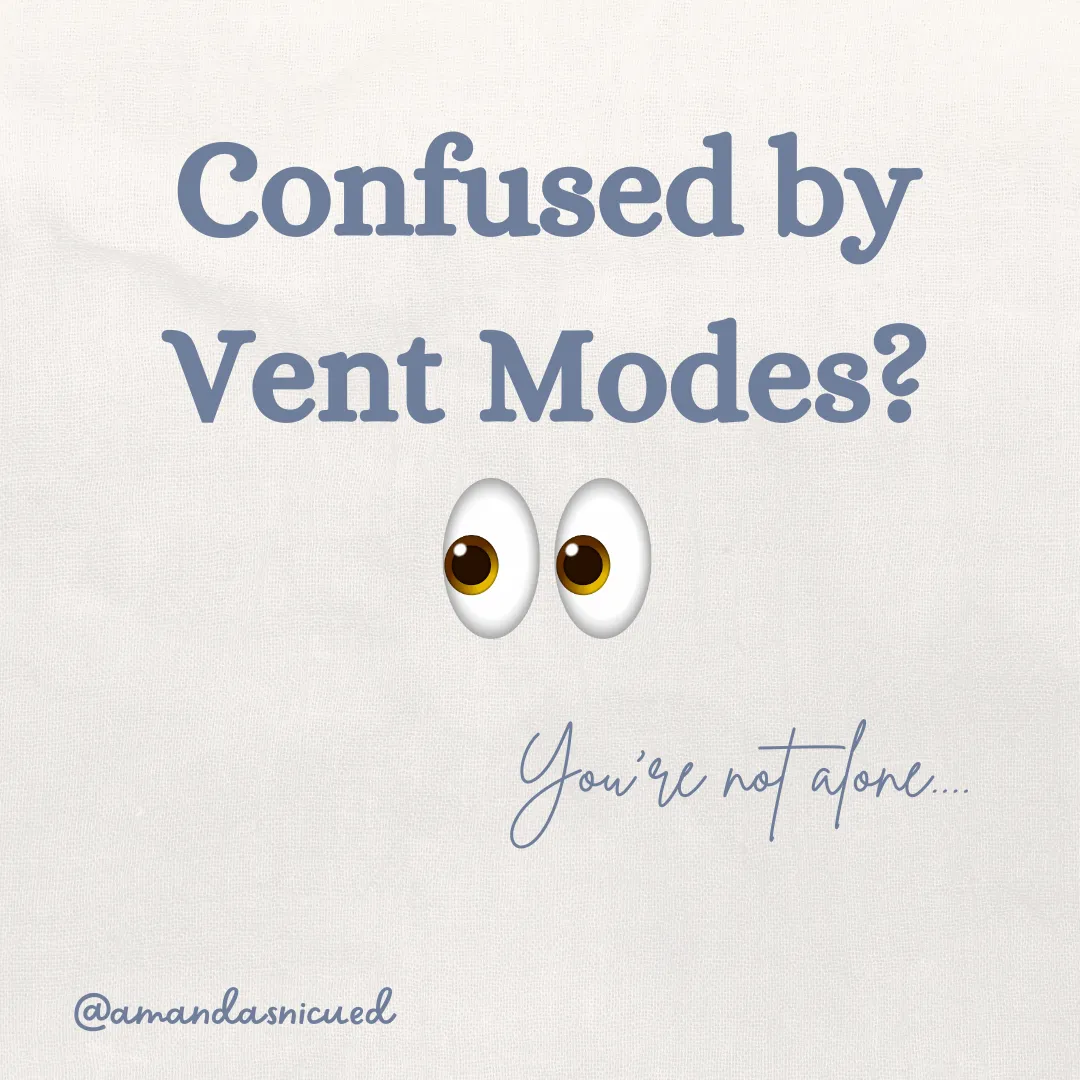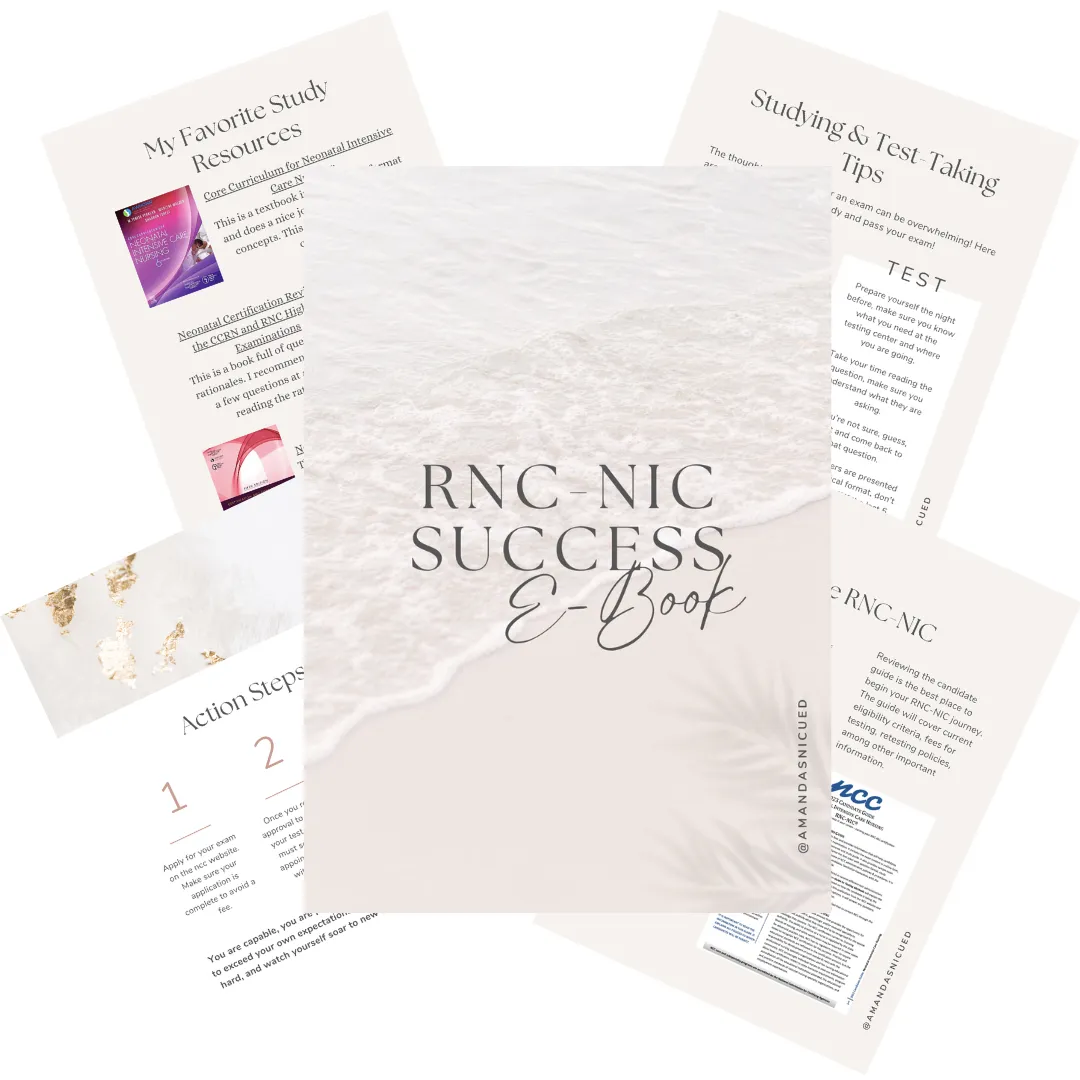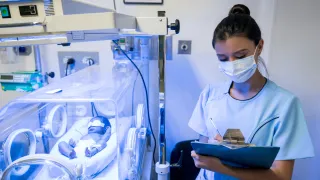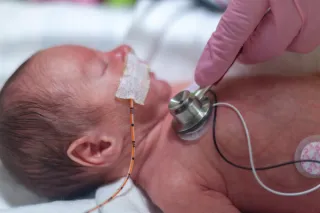
Welcome to Amanda's NICU Education




Hi! My name is Amanda. I'm a NICU nurse, Clinical Nurse Specialist, NICU Educator... basically your NICU BFF. If you want to talk NICU, I'm here for you! I love everything about NICU nursing and I'm eager to learn and share my knowledge with all my NICU friends.
I have been a NICU nurse since 2009 I am currently a Clinical Nurse Specialist in a Level IV NICU in Los Angeles.
I am passionate about educating the next generation of NICU nurses. I share my knowledge through platforms such as Instagram and Facebook and am excited to have you here on my website!
Click on the button below to sign up for my newsletter filled with NICU education and tips for all experience levels.

Not very many people love taking tests but as a self-acclaimed "forever student" who has taken (and passed) five different certification exams I am no longer afraid of tests! "Way to brag", you might be thinking but I want to help YOU pass your certification exam too!
Introducing Amanda's RNC-NIC Success digital course - your ultimate study companion!
Gain unlimited, on-demand access for life, ensuring you're primed to ace your certification exam.
I'm here to help you succeed and I can't wait for you to share with me that you PASSED the RNC-NIC EXAM!!!










Modes of Ventilation
I have a confession... the different modes of mechanical ventilation have always been a little bit of a struggle for me. I never felt like I learned them in a way that made them stick. Sure, I can explain the difference between SIMV and high-frequency ventilation, but when someone asks me about all the combinations of modes and hybrid modes (PRVC, SIMV-VG, PSV) I still have to look it up to make sure I know what I’m talking about.
What’s helped me most? Talking to my RTs and refusing to feel ashamed for asking questions. They went to school specifically for this, and I’ve learned so much by just saying, “Hey, can you walk me through why we’re using this mode?” This collaboration has built my confidence and reminded me that NICU care is a team sport.
If you’ve ever felt lost looking at the ventilator screen or nervous about reporting a change because you weren’t sure what it meant... this newsletter is for you. By the end, I hope you feel more confident at the bedside, more comfortable explaining what’s happening to parents, and more empowered to advocate for your patients.
Invest in yourself with the Certification Review Course
🫁 NICU Ventilation 101: Modes of Mechanical Ventilation
Mechanical ventilation is one of the most critical therapies we use in the NICU, yet it can feel intimidating. Understanding how each mode works will help you interpret ventilator changes, recognize when your patient is improving or decompensating, and collaborate confidently with the RTs and the medical team.
💡 Why Understanding Ventilation Modes Matters
Our goal with mechanical ventilation is to optimize ventilation, oxygenation, while protecting the lungs from injury:
Preventing volutrauma (injury from over-distension)
Preventing barotrauma (injury from high pressures)
Avoiding atelectrauma (repetitive alveolar collapse and reopening)
Reducing biotrauma (inflammatory injury from mechanical stress)
Our goal is to use a lung-protective strategy:
Keep the lung open with adequate PEEP
Deliver appropriate tidal volumes (usually 4–6 mL/kg)
Support spontaneous breathing when possible
Extubate as soon as safely feasible
Choosing the right mode allows us to match support to the baby's needs while minimizing harm. Nurses are the first to notice subtle changes in chest rise, synchrony, or blood gases so your understanding is essential.

Image(s) used under license from Shutterstock.com
🫁Conventional Ventilation Modes
1️⃣ Pressure-Controlled Ventilation (PC)
How it works: The ventilator delivers breaths until a set inspiratory pressure (PIP) is reached. The resulting tidal volume (VT) can vary depending on lung compliance and airway resistance.
Why we use it in the NICU:
PC protects preterm lungs by capping peak pressure
Provides a natural decelerating flow pattern. There may be high flow at the start, tapering as alveoli fill. This improves gas distribution and comfort
Particularly helpful when lung compliance is rapidly changing (e.g., during surfactant administration, or recovery from atelectasis)
Nursing considerations:
Carefully monitor delivered tidal volume and chest excursion.
If compliance worsens, VT may drop → hypoventilation
If compliance improves, VT may rise → risk of over-distension unless PIP is titrated down
Watch for patient–ventilator synchrony.
Improper trigger sensitivity can increase the work of breathing
Mini case study: A 28-week infant would show improving compliance after receiving surfactant therapy. You notice the VT increasing from 4 mL/kg to 7 mL/kg with the same PIP. This is your cue to alert the team that PIP may need to be weaned to prevent overdistension.
2️⃣ Volume-Controlled Ventilation (VC)
How it works: The ventilator delivers a set tidal volume regardless of compliance (within safety pressure limits). Peak pressures vary depending on lung mechanics.
Why we use it:
Guarantees a consistent VT. This can be very helpful for precise CO₂ control
Shown to reduce death, BPD, pneumothorax, and intracranial hemorrhage.
Nursing considerations:
Monitor peak inspiratory pressures
If compliance worsens, pressures can climb rapidly → risk of barotrauma
Look for signs of over-distension (hyperinflated chest, increased transcutaneous CO₂ despite high VT)
Clinical pearl: Volume control is like cruise control in your car. It maintains the "speed" (tidal volume) but the "gas pedal pressure" (PIP) adjusts automatically based on "road conditions" (lung compliance).
3️⃣ Volume-Targeted / Volume Guarantee (VG)
How it works: This is a hybrid mode:
Each breath is still pressure-controlled (so you set a PIP limit and Ti).
The ventilator continuously monitors exhaled tidal volume and adjusts the pressure up or down breath-to-breath to meet the target VT.
Result: You get a consistent VT like VC, but with the safety of pressure control (lower risk of barotrauma).
Benefits in neonates:
Reduced duration of ventilation.
Lower risk of BPD, IVH, pneumothorax, and hypocarbia.
Automatically “weans” support as lung compliance improves (less need for constant manual adjustment).
4️⃣ Pressure Support Ventilation (PSV)
How it works: Every spontaneous breath receives a preset pressure boost. No set rate. Completely patient driven.
Why it's used: Often as a weaning step to extubation. PSV promotes spontaneous breathing but makes it easier for the baby to overcome circuit resistance.
Nursing considerations:
Monitor respiratory rate, effort, and tidal volumes:
if apnea or hypoventilation occurs, the baby may not be ready for PSV alone
Ensure back-up ventilation (apnea time or minimum rate) is set in case of apnea
🫁Synchronized Intermittent Mandatory Ventilation (SIMV)
How it works:
Delivers a set number of mandatory breaths per minute, synchronized with the infant’s inspiratory effort.
Between these mandatory breaths, the baby can breathe spontaneously. These breaths can be supported with pressure support (PS) to decrease the work of breathing.
Why we use it:
Great for weaning. As the infant’s lung function improves, the mandatory breath rate can be gradually decreased until the baby is breathing mostly on their own.
Encourages spontaneous breathing, maintaining respiratory muscle strength.
Nursing Considerations:
Monitor work of breathing as the SIMV rate is weaned. Fatigue or rising CO₂ may signal the infant isn’t ready for a lower rate yet.
Ensure PS level is adequate... too low can tire out the infant, too high can suppress their natural drive.
💨Assist-Control (A/C) or Synchronized Intermittent Positive Pressure Ventilation (SIPPV)
How it works:
Every patient-triggered breath receives a full ventilator-delivered breath with set PIP (or VT if using VG).
A backup rate is provided if the baby becomes apneic.
Why we use it:
Ideal for acute illness or when full support is needed.
Ensures consistent support and stable CO₂ clearance.
Nursing Considerations:
Watch for tachypnea or auto-triggering: this can lead to hypocarbia (which can reduce cerebral blood flow and increase IVH risk).
Report rising oxygen needs or increasing PIP requirements: this could indicate worsening compliance or an evolving process like pneumothorax.

🔈 High-Frequency Ventilation
When conventional ventilation can't provide adequate gas exchange without risking lung injury, we move to high-frequency ventilation:
HFOV (High-Frequency Oscillatory Ventilation)
Provides tiny tidal volumes at extremely high frequencies (up to 900 breaths/min) around a set mean airway pressure
Keeps alveoli constantly recruited ("open lung strategy"). This is great for diffuse lung disease (severe RDS, pulmonary hemorrhage)
Nursing tip: The chest should "wiggle” kinda like like Jell-O. If you don't see the wiggle, check for circuit leaks, kinks, or airway obstruction.
HFJV (High-Frequency Jet Ventilation)
Delivers short, high-velocity "jet" pulses of gas
Excellent for babies with air leaks, PIE, or hyperinflation since exhalation is passive and CO₂ clearance is very efficient
🧠 Advanced Modes: PAV & NAVA
PAV (Proportional Assist Ventilation): Ventilator pressure is proportional to the infant’s own effort — supports but doesn’t take over breathing.
NAVA (Neurally Adjusted Ventilatory Assist): Uses diaphragm electrical activity to trigger breaths, giving unmatched synchrony and patient comfort.
Both may reduce work of breathing but require careful setup and understanding. More studies are needed before they become standard in ELBW infants
🧠 Disease-Specific Approach (Examples)

📊 Key Ventilator Parameters to Monitor
The 6 Settings Every NICU Nurse Should Know:
Rate - Breaths per minute delivered by ventilator
PIP (Peak Inspiratory Pressure) - Maximum pressure during inspiration
PEEP (Positive End-Expiratory Pressure) - Pressure maintained at end of expiration
iT - inspiratory time in seconds (usually 0.33-0.4 but will be longer in babies with BPD)
FiO₂ - Fraction of inspired oxygen
Flow - Speed of gas delivery
What Changes Mean:
↑ Rate = More ventilator breaths (increases CO₂ removal)
↑ PIP = More driving pressure (a bigger breath)
↑ PEEP = More alveolar recruitment (improves oxygenation)
↑ FiO₂ = More oxygen support
🚨 Red Flags: When to Call the Team
Immediate Concerns:
Sudden deterioration → Consider the DOPE mnemonic:
Displacement: is the ETT too deep? Too high? Is it completely out?
Obstruction: is there kinking or some other obstruction (e.g. mucous plug?)
Pneumothorax: assess the chest, are breath sounds or chest rise bilateral? Consider transillumination
Equipment failure: Is the equipment working?
Chest not rising despite high pressures → Check for ETT obstruction or displacement
Frequent apnea on PSV → Baby may need more support
Fighting the ventilator → Check synchrony with the RT, sedation needs, or pain
Trending Concerns to Report:
Increasing oxygen requirements over shift. Does unit have a standard to increase the medical team? For example, notify MD for fiO2 >10% from baseline
Decreasing tidal volumes with same settings
Worsening TCOM, etCO2, or blood gas trends
Changes in chest excursion or breath sounds
🧠 Your Role as the Bedside Nurse
Assess Synchrony
Look for retractions, "fighting the vent," or high trigger asynchrony alarms. A well-synchronized baby will have:
Gentle chest rise that matches ventilator breaths
Minimal accessory muscle use
Comfortable appearance
Trend Blood Gases
Correlate changes with ventilator settings and patient condition:
pH ↓ + CO₂ ↑ = Need more ventilation (rate or VT)
pH ↑ + CO₂ ↓ = May be over-ventilating
PaO₂ ↓ = May need more PEEP or FiO₂
Monitor for Complications
Pneumothorax: Sudden deterioration, unequal chest movement, shift in heart sounds
BPD risk: Prolonged high pressures or FiO₂
Hypocarbia: Can reduce cerebral blood flow increasing the risk of IVH and PVL
Is the baby ready to be weaned?
Report when you notice:
Improved spontaneous breathing efforts
Oxygen needs dropping
VT exceeding target range
Baby appearing more comfortable These may indicate readiness for setting reductions or extubation trials.
👨👩👧👦 Supporting Families Through Ventilation
Key Messages for Parents:
"We adjust settings based on what your baby needs"
"Your baby can still hear your voice and feel your touch"
"Every day we're working toward the goal of breathing independently"
What to Explain:
The sounds from the ventilator are normal and expected
Settings change frequently. This is to optimize breathing and help support the baby toward breathing on their own.
How they can still bond (talking, holding, skin to skin, reading)
What improvements look like (less support needed over time)
🎯 Case Study: Putting It All Together
Patient: 32-week infant, Day 2 of life, s/p surfactant for RDS
Current settings: PC-SIMV, Rate 30, PIP 22, PEEP 6, FiO₂ 0.25, PS 8
Your assessment at 0800:
Chest rise adequate and symmetric
SpO₂ 90-96%
Spontaneous rate 45 (15 over set rate)
VT averaging 5.2 mL/kg
Blood gas: pH 7.35, CO₂ 45, PaO₂ 70
By 1400, you notice:
Same chest rise but VT now 6.8 mL/kg
SpO₂ easily maintaining 95-98%, FiO₂ is now 0.21
Spontaneous rate increased to 50
What's happening? Lung compliance is improving post-surfactant. The baby is getting more volume with the same pressure and showing increased spontaneous efforts.
Your action: Report to team that baby may be ready for weaning! As a team we could consider reducing the PIP to 20 and decreasing set rate to encourage more spontaneous breathing.
🔍 Active Learning Challenge
For the next week, choose one patient on mechanical ventilation and:
Identify their current mode and why it was chosen
Track their key parameters over your shift
Note any changes you observe
Discuss with the team what the next step might be
Share your observations with colleagues, we all learn from each other's experiences!
🧾 Practical Nursing Takeaways
Trend delivered VT in PC or SIMV, don’t rely on set PIP alone.
Minimize circuit disconnections to preserve functional residual capacity.
Communicate readiness for weaning/extubation: when FiO₂ drops, spontaneous breathing improves, or VT is consistently higher than target.
Educate families: explain in simple terms how the ventilator is helping their baby breathe and what signs of progress mean.
Stay curious: Learn "why" when the settings change. Understanding the rationale makes you a better advocate
If you found this breakdown of ventilator modes helpful, then you’ll love my Neonatal Certification Review Course. The course is built on the same idea, taking complex NICU concepts (like vent modes, hemodynamics, and pathophysiology) and breaking them down into simple, understandable lessons you can actually use at the bedside and on your exam.
💡 Whether you’re studying for the RNC-NIC or CCRN-N, or you just want to feel more confident in your NICU practice, this course is designed for you.
👉 Click the button below to join the course and start turning those confusing topics into your strengths.
Your certification, and your confidence, are waiting! 🤩

Get this CUTE NICU Nurse Era t-shirt from my friends at Nicuity
Questions? Want to share a challenging case or success story? Reply to this newsletter. I love hearing from you!
Stay Curious
Amanda
© 2025 This content is for educational purposes and should complement, not replace, your unit's policies and procedures.
Missed my other newsletters? Click here to read them!
References:
Chakkarapani, A. A., Adappa, R., Mohammad Ali, S. K., Gupta, S., Soni, N. B., Chicoine, L., & Hummler, H. D. (2020). Current concepts in assisted mechanical ventilation in the neonate—Part 2: Understanding various modes of mechanical ventilation and recommendations for individualized disease-based approach in neonates. International Journal of Pediatrics and Adolescent Medicine, 7(4), 201–208. https://doi.org/10.1016/j.ijpam.2020.11.002
Courtney, S. E., & Durand, D. J. (2025). Neonatal respiratory therapy. In R. J. Martin, A. A. Fanaroff, & M. C. Walsh (Eds.), Fanaroff and Martin’s neonatal-perinatal medicine: Diseases of the fetus and infant (11th ed., pp. 559–576). Elsevier.
Keszler, M., & Chatburn, R. L. (2017). Overview of assisted ventilation. In M. Keszler (Ed.), Assisted ventilation of the neonate: An evidence-based approach to newborn respiratory care (6th ed., pp. 251–263). Elsevier. https://doi.org/10.1016/B978-0-323-39006-4.00015-6
Klingenberg, C., Wheeler, K. I., McCallion, N., Morley, C. J., & Davis, P. G. (2017). Volume-targeted versus pressure-limited ventilation in neonates. Cochrane Database of Systematic Reviews, 10, CD003666. https://doi.org/10.1002/14651858.CD003666.pub4
Cloherty, J. P., Eichenwald, E. C., Hansen, A. R., & Stark, A. R. (Eds.). (2017). Manual of neonatal care (8th ed.). Wolters Kluwer.
Martin, R. J., Fanaroff, A. A., & Walsh, M. C. (2020). Fanaroff and Martin’s neonatal-perinatal medicine: Diseases of the fetus and infant (11th ed.). Elsevier.

Copyright © {{right_now.year}} {{location.name}}, All rights reserved.

December 2023 Certification Review Webinar
NICU Certification Review



Ready to kickstart your journey to becoming a certified NICU nurse?
Look no further!
Grab my FREE E-Book packed with essential study and test-taking strategies for the RNC-NIC.
In the E-Book I give you the resources you need including the link to access the candidate guide, several types of books to study from, some of my favorite strategies, an outline of the content you should review, and a blank calendar for you to make your study plan!
Frequently Asked Questions About the RNC-NIC exam

What is the RNC-NIC?
The RNC-NIC is a competency-based exam that tests the specialty knowledge of nurses in the United States & Canada who care for critically ill newborns and their families.
The RNC-NICU is a nationally recognized certification that recognizes the registered nurse for their specialty knowledge and skill.

Who can take the RNC-NIC exam?
Nurses can take this exam after a minimum of two years experience in the NICU caring for critically ill newborns and their families.

Which books should I use?
I'm glad you asked! There are many excellent books to help you prepare for the RNC-NIC, I gathered ande describe each of them for you in my FREE e-book.
Is there a course to help me study?
Yes! Many hospitals host their own certification course and there are a few online courses. See my RNC-NIC test taking tips E Book for more information
What happens if I don't pass the exam?
If you don't pass the exam on your first try you can try again after 90 days. You will have to reapply after 90 days and pay a retest fee. There is no limit to the number of times you can take the exam (however a candidate can only sit for the exam twice per year).

Can I make more money if I take the RNC-NIC exam and get certified?
Yes! Many hospitals provide a raise or a bonus for nurses with specialty certifications. Hospitals also typically hire at a higher base salary when nurses have a certification.

Find me @amandasnicued on these channels or Email me
hey nurses don't miss out
© Copyright 2024. AmandasNICUEd. All rights reserved. | Terms & Conditions | Privacy Policy Contact: [email protected]

